Kuiper belt - Study guides, Revision notes & Summaries
Looking for the best study guides, study notes and summaries about Kuiper belt? On this page you'll find 81 study documents about Kuiper belt.
All 81 results
Sort by
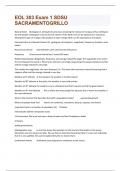 Popular
Popular
-
EOL 303 Exam 1 SDSU SACRAMENTOGRILLO QUESTIONS WITH ALL CORRECT SOLUTIONS!!
- Exam (elaborations) • 5 pages • 2024
- Available in package deal
-
- £6.57
- 1x sold
- + learn more
Natural Event Geological or atmospheric processes involving the release of energy and has nothing to do with people. Geological is due to the hot interior of the Earth and can be expressed as volcanoes. Atmospheric type of energy is the product of solar energy which can be expressed as tornadoes. Characteristics of a Natural Disaster (5) geological, atmospheric, magnitude, frequency, duration, areal extent Recurrence interval time between same sized events (150 years) frequency 1/recurrenc...
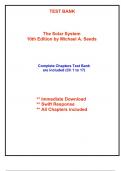 Popular
Popular
-
Test Bank for The Solar System, 10th Edition Seeds (All Chapters included)
- Exam (elaborations) • 297 pages • 2024 Popular
-
- £24.24
- 1x sold
- + learn more
Complete Test Bank for The Solar System, 10th Edition by Michael A. Seeds ; ISBN13: 9781337399937...(Full Chapters included Chapter 1 to 17)...1. Here and Now. 2. A User's Guide to the Sky. 3. Moon Phases and Eclipses. 4. Origins of Modern Astronomy. 5. Gravity. 6. Light and Telescopes. 7. Atoms and Spectra. 8. The Sun. 9. Origins of Stars, Galaxies, and the Universe. 10. Origin of the Solar System and Extrasolar Planets. 11. Earth: The Active Planet. 12. The Moon and Mercury: Compari...

-
ASTR 205 Final Exam
- Exam (elaborations) • 7 pages • 2023
- Available in package deal
-
- £8.22
- 4x sold
- + learn more
What makes up 99.8% of the solar system's mass? The sun Mercury, Venus, Earth and Mars are called what type of planets? Terrestrial Terrestrial planets are ________ in size and ______ in mass and have a _______ density of 3.9-5.5 g/cm3 Small; Low; High What terrestrial planet is the densest of them all. Earth Jupiter, Saturn, Uranus and Neptune are called what types of planets? Jovian Jovian planets are ______ is size, ______ in mass and have a _______ density of about 0.7-1.6 g/c...
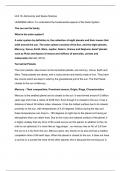
-
Unit 16 - Learning Aim A Distinction Achieved
- Essay • 19 pages • 2023
- Available in package deal
-
- £17.49
- 2x sold
- + learn more
Distinction achieved. Describes: • Planets - Composition, Rings, Characteristics, Origin • Solar system • Gaseous ans Terrestrial Planets • Sun compostion • Kuiper belt, Van Allen radiation, Forces applied
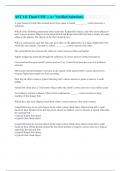
-
AST 111 Final CMU || A+ Verified Solutions.
- Exam (elaborations) • 19 pages • 2024
- Available in package deal
-
- £10.68
- + learn more
A rock found on Earth that crashed down from space is called _________. correct answers a meteorite Which of the following statements about asteroids, Kuiper belt objects, and Oort cloud objects is true? correct answers Objects in the asteroid belt and Kuiper belt orbit the Sun in nearly the same plane as the planets, but objects in the Oort cloud do not. When a comet passes near the Sun, part of it takes on the appearance of a large, bright ball from which the tail extends. This part is c...
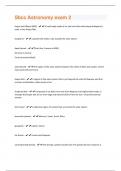
-
Sbcc Astronomy exam 2 Questions With 100% Correct Answers
- Exam (elaborations) • 10 pages • 2024
- Available in package deal
-
- £6.57
- + learn more
Kuiper belt Object (KBO) - A small body made of ice and rock that orbits beyond Neptune's orbit, in the Kuiper Belt. Exoplanet - a planet that orbits a star outside the solar system dwarf planet - Pluto (has 5 moons in KBO) Eris (has 5 moons) Ceres (in asteroid belt) asteroid belt - the region of the solar system between the orbits of Mars and Jupiter, where many asteroids are found Kuiper belt - A region of the solar system that is just beyond the orbit of Neptune and that contains sm...
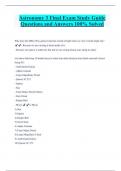
-
Astronomy 3 Final Exam Study Guide Questions and Answers 100% Solved
- Exam (elaborations) • 34 pages • 2024
- Available in package deal
-
- £12.32
- + learn more
Astronomy 3 Final Exam Study Guide Questions and Answers 100% Solved Why does the Milky Way galaxy look like a band of light when we view it in the night sky? ️️- Because we are viewing it from inside of it. - Because our galaxy is relatively flat and we are seeing distant stars along its plane. List these following 10 bodies/areas in order from their distance from Earth outward (closest being #1): - Andromeda Galaxy - Alpha Centauri - Large Magellanic Cloud - Quasar 3C 273 - Ju...
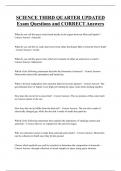
-
SCIENCE THIRD QUARTER UPDATED Exam Questions and CORRECT Answers
- Exam (elaborations) • 20 pages • 2024
-
- £7.80
- + learn more
SCIENCE THIRD QUARTER UPDATED Exam Questions and CORRECT Answers What do you call the space rocks found mostly in the region between Mars and Jupiter? - Correct Answer- Asteroids What do you call the icy rocks that travel from either the Kuiper Belt or from the Oort Cloud? - Correct Answer- Comet What do you call the space rocks which are remnants of either an asteroid or a comet? - Correct Answer- Meteoroid
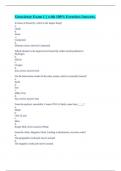
-
Geoscience Exam 1 || with 100% Errorless Answers.
- Exam (elaborations) • 12 pages • 2024
- Available in package deal
-
- £9.44
- + learn more
In terms of hierarchy, which is the largest thing? a. Quark b. Atom c. Compound d. Element correct answers Compound Which element is the largest to be formed by stellar nucleosynthesis?a. Hydrogen b. Silicon c. Oxygen d. Iron correct answers Iron For the heliocentric model of the solar system, which is centrally located? a. Earth b. Sun c. Milky Way d. Star correct answers Sun From the podcast, snowdrifts, Comet 67P/C-G likely came from_____? a. P...
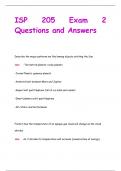
-
ISP 205 Exam 2 Questions and AnswersISP 205 Exam 2 Questions and Answers
- Exam (elaborations) • 26 pages • 2024
- Available in package deal
-
- £10.27
- + learn more
Describe the major patterns we find among objects orbiting the Sun. Ans- -Terrestrial planets: rocky planets -Jovian Planets: gaseous planets -Asteroid belt between Mars and Jupiter -Kuiper belt past Neptune full of ice balls and comets -Dwarf planets orbit past Neptune -All rotate counterclockwise Predict how the temperature of an opaque gas cloud will change as the cloud shrinks Ans- As it shrinks its temperature will increase (conservation of energy) Explain how the nebular theory ...

Study stress? For sellers on Stuvia, these are actually golden times. KA-CHING! Earn from your revision notes too and start uploading now. Discover all about earning on Stuvia


